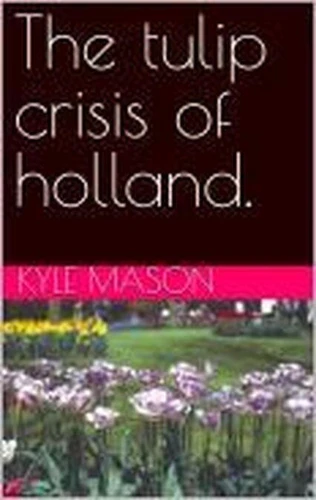The Tulip crisis of Holland
Par :Formats :
Disponible dans votre compte client Decitre ou Furet du Nord dès validation de votre commande. Le format ePub est :
- Compatible avec une lecture sur My Vivlio (smartphone, tablette, ordinateur)
- Compatible avec une lecture sur liseuses Vivlio
- Pour les liseuses autres que Vivlio, vous devez utiliser le logiciel Adobe Digital Edition. Non compatible avec la lecture sur les liseuses Kindle, Remarkable et Sony
 , qui est-ce ?
, qui est-ce ?Notre partenaire de plateforme de lecture numérique où vous retrouverez l'ensemble de vos ebooks gratuitement
Pour en savoir plus sur nos ebooks, consultez notre aide en ligne ici
- FormatePub
- ISBN8224108411
- EAN9798224108411
- Date de parution02/08/2024
- Protection num.pas de protection
- Infos supplémentairesepub
- ÉditeurVirtued Press
Résumé
The Tulip Crisis of Holland, also known as Tulip Mania, was a period during the Dutch Golden Age in the early 17th century when prices for some bulbs of the recently introduced and fashionable tulips reached extraordinarily high levels and then dramatically collapsed. It is often considered one of the first recorded speculative bubbles in history.### Key Aspects of the Tulip Crisis1. **Origins of Tulip Mania**: - Tulips were introduced to Europe from the Ottoman Empire in the mid-16th century. - They became highly prized for their beauty, rarity, and variety, especially among the wealthy.2.
**The Boom Phase**: - By the early 1630s, the demand for tulips grew rapidly, and the market for tulip bulbs became highly speculative. - Tulip bulbs were traded frequently, with prices rising to extraordinary levels. Some single tulip bulbs were sold for more than the cost of a house.3. **Speculative Bubble**: - The trade was initially conducted among professional growers and wealthy individuals, but it soon attracted speculators from all walks of life. - Contracts for future delivery of bulbs were bought and sold, often without the bulbs changing hands, similar to modern futures trading.4.
**Peak and Collapse**: - Tulip prices peaked in the winter of 1636-1637. - In February 1637, the market suddenly collapsed. Prices plummeted, and many investors faced financial ruin. - The collapse was rapid, with some tulip contracts becoming worthless overnight.5. **Aftermath and Impact**: - The immediate economic impact was limited, affecting mainly those who were directly involved in the speculation. - However, the event has been used historically as a cautionary tale about the dangers of speculative bubbles and irrational exuberance in markets. - The Dutch economy continued to thrive after the mania, but the event left a lasting mark on economic history and popular culture.### Historical Context- **Economic Environment**: The Dutch Republic was experiencing a period of prosperity, with flourishing trade, finance, and art.- **Cultural Fascination**: The tulip, with its exotic origins and striking appearance, became a status symbol and a cultural obsession.### Modern Interpretations- **Economic Lessons**: Tulip Mania is often cited in discussions of market bubbles, illustrating how speculative fervor can lead to irrational market behavior.- **Psychological Insights**: The phenomenon is studied to understand the psychology of speculation and the factors that drive people to invest in increasingly overvalued assets.### ConclusionThe Tulip Crisis of Holland remains a fascinating episode in economic history, symbolizing the complexities and risks of speculative markets.
It serves as a reminder of the potential consequences of unchecked speculation and the enduring allure of rare and beautiful objects in driving economic behavior.
**The Boom Phase**: - By the early 1630s, the demand for tulips grew rapidly, and the market for tulip bulbs became highly speculative. - Tulip bulbs were traded frequently, with prices rising to extraordinary levels. Some single tulip bulbs were sold for more than the cost of a house.3. **Speculative Bubble**: - The trade was initially conducted among professional growers and wealthy individuals, but it soon attracted speculators from all walks of life. - Contracts for future delivery of bulbs were bought and sold, often without the bulbs changing hands, similar to modern futures trading.4.
**Peak and Collapse**: - Tulip prices peaked in the winter of 1636-1637. - In February 1637, the market suddenly collapsed. Prices plummeted, and many investors faced financial ruin. - The collapse was rapid, with some tulip contracts becoming worthless overnight.5. **Aftermath and Impact**: - The immediate economic impact was limited, affecting mainly those who were directly involved in the speculation. - However, the event has been used historically as a cautionary tale about the dangers of speculative bubbles and irrational exuberance in markets. - The Dutch economy continued to thrive after the mania, but the event left a lasting mark on economic history and popular culture.### Historical Context- **Economic Environment**: The Dutch Republic was experiencing a period of prosperity, with flourishing trade, finance, and art.- **Cultural Fascination**: The tulip, with its exotic origins and striking appearance, became a status symbol and a cultural obsession.### Modern Interpretations- **Economic Lessons**: Tulip Mania is often cited in discussions of market bubbles, illustrating how speculative fervor can lead to irrational market behavior.- **Psychological Insights**: The phenomenon is studied to understand the psychology of speculation and the factors that drive people to invest in increasingly overvalued assets.### ConclusionThe Tulip Crisis of Holland remains a fascinating episode in economic history, symbolizing the complexities and risks of speculative markets.
It serves as a reminder of the potential consequences of unchecked speculation and the enduring allure of rare and beautiful objects in driving economic behavior.
The Tulip Crisis of Holland, also known as Tulip Mania, was a period during the Dutch Golden Age in the early 17th century when prices for some bulbs of the recently introduced and fashionable tulips reached extraordinarily high levels and then dramatically collapsed. It is often considered one of the first recorded speculative bubbles in history.### Key Aspects of the Tulip Crisis1. **Origins of Tulip Mania**: - Tulips were introduced to Europe from the Ottoman Empire in the mid-16th century. - They became highly prized for their beauty, rarity, and variety, especially among the wealthy.2.
**The Boom Phase**: - By the early 1630s, the demand for tulips grew rapidly, and the market for tulip bulbs became highly speculative. - Tulip bulbs were traded frequently, with prices rising to extraordinary levels. Some single tulip bulbs were sold for more than the cost of a house.3. **Speculative Bubble**: - The trade was initially conducted among professional growers and wealthy individuals, but it soon attracted speculators from all walks of life. - Contracts for future delivery of bulbs were bought and sold, often without the bulbs changing hands, similar to modern futures trading.4.
**Peak and Collapse**: - Tulip prices peaked in the winter of 1636-1637. - In February 1637, the market suddenly collapsed. Prices plummeted, and many investors faced financial ruin. - The collapse was rapid, with some tulip contracts becoming worthless overnight.5. **Aftermath and Impact**: - The immediate economic impact was limited, affecting mainly those who were directly involved in the speculation. - However, the event has been used historically as a cautionary tale about the dangers of speculative bubbles and irrational exuberance in markets. - The Dutch economy continued to thrive after the mania, but the event left a lasting mark on economic history and popular culture.### Historical Context- **Economic Environment**: The Dutch Republic was experiencing a period of prosperity, with flourishing trade, finance, and art.- **Cultural Fascination**: The tulip, with its exotic origins and striking appearance, became a status symbol and a cultural obsession.### Modern Interpretations- **Economic Lessons**: Tulip Mania is often cited in discussions of market bubbles, illustrating how speculative fervor can lead to irrational market behavior.- **Psychological Insights**: The phenomenon is studied to understand the psychology of speculation and the factors that drive people to invest in increasingly overvalued assets.### ConclusionThe Tulip Crisis of Holland remains a fascinating episode in economic history, symbolizing the complexities and risks of speculative markets.
It serves as a reminder of the potential consequences of unchecked speculation and the enduring allure of rare and beautiful objects in driving economic behavior.
**The Boom Phase**: - By the early 1630s, the demand for tulips grew rapidly, and the market for tulip bulbs became highly speculative. - Tulip bulbs were traded frequently, with prices rising to extraordinary levels. Some single tulip bulbs were sold for more than the cost of a house.3. **Speculative Bubble**: - The trade was initially conducted among professional growers and wealthy individuals, but it soon attracted speculators from all walks of life. - Contracts for future delivery of bulbs were bought and sold, often without the bulbs changing hands, similar to modern futures trading.4.
**Peak and Collapse**: - Tulip prices peaked in the winter of 1636-1637. - In February 1637, the market suddenly collapsed. Prices plummeted, and many investors faced financial ruin. - The collapse was rapid, with some tulip contracts becoming worthless overnight.5. **Aftermath and Impact**: - The immediate economic impact was limited, affecting mainly those who were directly involved in the speculation. - However, the event has been used historically as a cautionary tale about the dangers of speculative bubbles and irrational exuberance in markets. - The Dutch economy continued to thrive after the mania, but the event left a lasting mark on economic history and popular culture.### Historical Context- **Economic Environment**: The Dutch Republic was experiencing a period of prosperity, with flourishing trade, finance, and art.- **Cultural Fascination**: The tulip, with its exotic origins and striking appearance, became a status symbol and a cultural obsession.### Modern Interpretations- **Economic Lessons**: Tulip Mania is often cited in discussions of market bubbles, illustrating how speculative fervor can lead to irrational market behavior.- **Psychological Insights**: The phenomenon is studied to understand the psychology of speculation and the factors that drive people to invest in increasingly overvalued assets.### ConclusionThe Tulip Crisis of Holland remains a fascinating episode in economic history, symbolizing the complexities and risks of speculative markets.
It serves as a reminder of the potential consequences of unchecked speculation and the enduring allure of rare and beautiful objects in driving economic behavior.
















